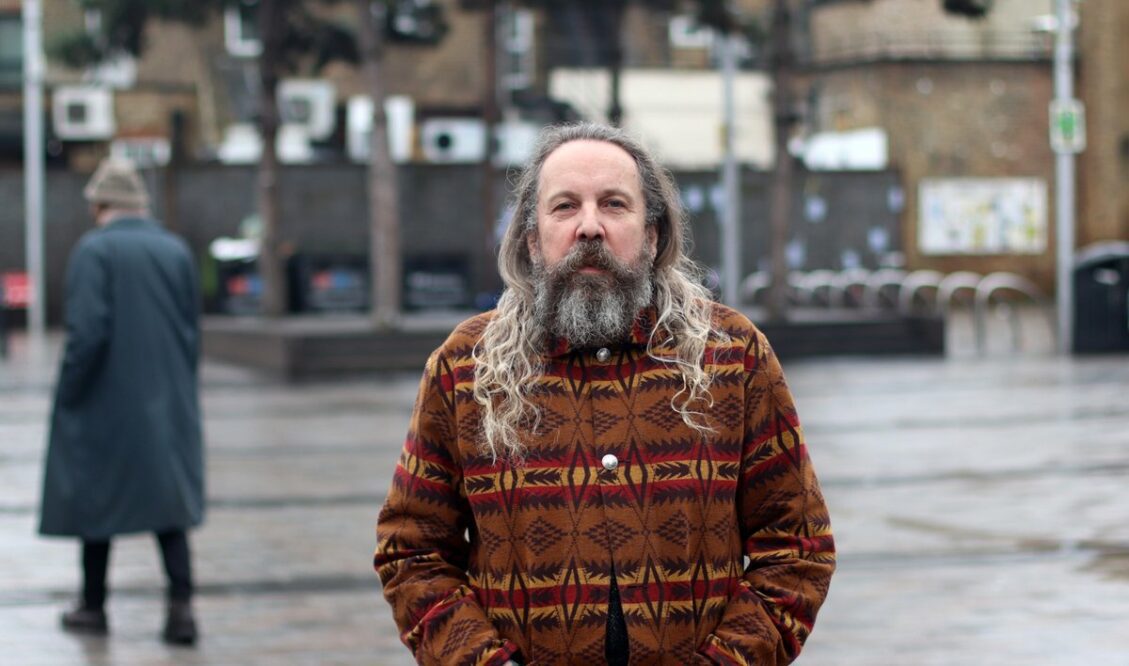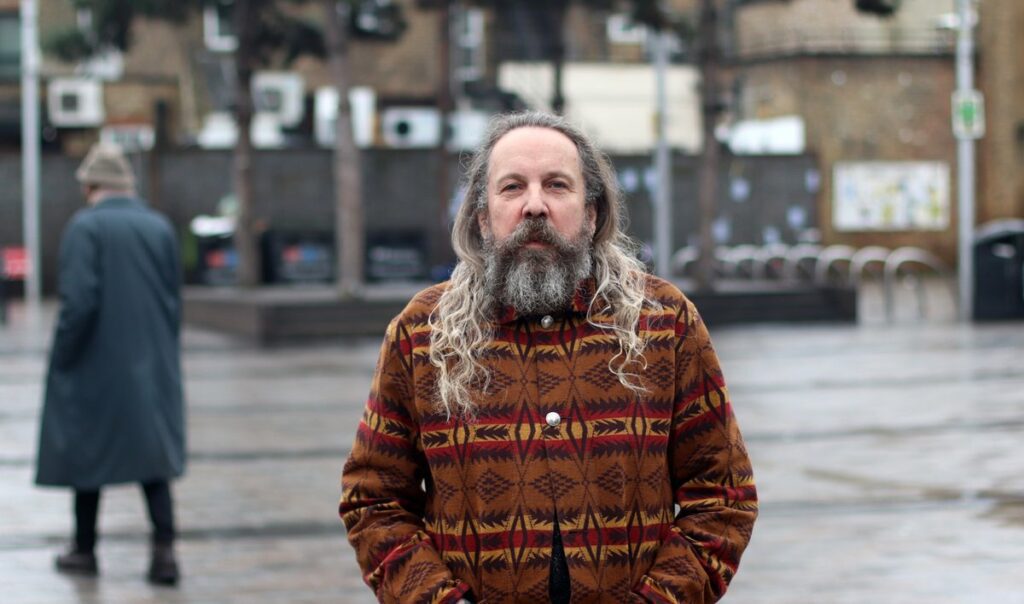

When Andrew Weatherall passed away in February 2020, there was little fanfare beyond radio stations playing an (abridged) ode to him, then moving on. Abridged, mostly, because Weatherall’s legendary DJ sets were epic in length, lasting hours upon hours. He just loved music. He loved a party. He was of the 24 Hour Party People era, lovingly transforming tracks by the Happy Mondays, Primal Scream, My Bloody Valentine, New Order and more into glitchy, gothic, dancefloor manna. Listening to his layers of acapella vocals, the hum and hiss of human and synth sounds, tropical percussion and dub-infused, somnambulant atmospherics is almost a religious experience. So hypnotic is the slow-build, the lushness of the soundscape he builds, that you may find yourself seeing the sun rise and set in the lifetime of just one track.
His name has arisen this month thanks to the double vinyl Warpaint mixes he masterminded, released as part of International Record Store Day on June 12. Weatherall mixed Warpaint’s debut album, The Fool back in 2010; both “Undertow” and “Baby” appeared on the official album, but much of his work on the record remained unheard. As announced on Warpaint’s Instagram, the new vinyl edition has arranged the tracks according to Weatherall’s design. While it’s wonderful that Warpaint fans may discover a new take on The Fool‘s master tapes, it would be a shame if the enormity of Weatherall’s career was not acknowledged and – hopefully – celebrated anew by music lovers globally. His remixes were, after all, legendary for good reason.
His 1990 remix of My Bloody Valentine’s “Soon” gave it primal drums, angelic harmonies and a slightly Calypso beat. It propelled a dreamy, angular indie track into club fare worthy of the eclectic 1990s UK rave and party scene that was embracing the sounds of trance, indie, weird and experimental electronica (ahem, Aphex Twin) and the post-romantic, New Wave/No Wave. My Bloody Valentine’s Loveless remains a classic of the time, recently reissued in all its moody glory. Weatherall was ahead of his time with this remix, as with many of his unexpected remix picks – knowing they’d stand the test of time even if the bands themselves weren’t known beyond their particular fanbase.
Weatherall’s love for Primal Scream made sense. Both Bobby Gillespie and Weatherall embraced the seemingly unfeasible mish-mash of indie rock, angular guitars, psychedelic pop with searing synths, the whip-snap drum machine, and vintage samples only true vinyl lovers could appreciate after digging through dusty boxes for the love of the find. His mix for “Higher Than The Sun (A Dub Symphony In Two Parts)” layers Gillespie’s exhale into a harmony of its own, sending dubby synths swirling in various shapes as the pace and mood change every few minutes. There are robotic bird noises, there are lasers, there are rattlesnake moans. It could be several songs, but the cohesiveness remains over almost eight minutes.
Perhaps his thrill at sculpting New Order’s music was similar to his love for Primal Scream. Both bands embraced the junction between angular indie rock and dance. His remix of “Regret (Sabres Fast’n’Throb)” turned it into a trance-like beast, with intertwining bass lines, a throbbing rave beat and barely any vocals. It’s art. It recalls Aphex Twin’s most beautiful, ambient works, and my personal favourites, “Polynomial-C” and “Didgeridoo.”
To appreciate his all-encompassing love affair with music, it’s necessary to understand that he wasn’t a musician or born into the rock industry. He was a regular, British, middle-class lad. Born in the early 1960s, Weatherall spent his Berkshire childhood surrounded by the emerging sounds of poppy balladeers, folk, anti-War protests, rock, and metal. His teenage years, towards the end of the 1970s and early 1980s were – as is often the case – formative in shaping his passion for particular bands and genres. The UK rave and club scene was emerging, party drugs were all the rage, and staying up all night dancing until the sun rose and the bleary streetlights appeared like salvation angels was just… growing up.
It sowed the seeds for the tastemaker he would become. He’d left home in his early twenties but was working odd jobs as a tradesman. Not until the late 1980s, when he’d moved to London, did he become known for spinning new indie records along with classic Northern Soul. He also established himself as a journalist and founder of Boy’s Own; initially a fanzine dedicated to fashion, music, soccer and culture, by 1990 it has morphed into a record label, representing electronica acts Underworld and The Chemical Brothers.
Like Weatherall himself, these acts carried the same spirited dedication to an experience. There is no need to be able to name either of The Chemical Brothers, nor any members of Underworld, to know what they make you feel when you hear “King Of Snake,” where if you close your eyes, neon lights splash around your inner vision until the percussive rave beat snaps all your synapses awake around the one-minute mark with its relentless pulsing stomp. Or the Chemical Brothers’ “Hey Boy Hey Girl,” with its repetitive, unforgettable hook “Superstar DJs, here we go!”
The acts he remixed are the sugary icing on the fudge cake. Weatherall is the dark chocolatey, addictive matter that coats your fingers as you dig right in. He was more than the cliché of a remix DJ, noodling away on software in the lonely confines of his bedroom while chopping up songs and changing the time signature. To assume his remixes were workmanlike is to not get him, or his art, at all. Rather, Weatherall’s remixes were new creations. He took the material and made it more than the sum of its parts; he heard the intention, and the passion, and it was these ephemeral qualities that he wove into his own makings.
If I’ve succeeded in whetting your appetite, and not just for chocolate fudge cake, then take this fork and plate and settle in for 900 hours of Weatherall’s archival mixes via The Weatherdrive. It remains a free resource, but in light of that, if you’re able to, consider making a charity donation or actually purchasing some of his work.
Where to begin, with 900 hours of material? I’d suggest two things. Either, at the beginning (of course), or with the BBC1 Essential Mix 1993, one of the earliest mixes in this longstanding series. Epic, relentless, genius and fabulous, it is the closest we can hope to feel to that first time of hearing a song and knowing you need to be in it somehow, melding it to your likeness, creating your own shapes within it and returning it to the world, anew, changed but fundamentally exactly what it’s meant to be.

